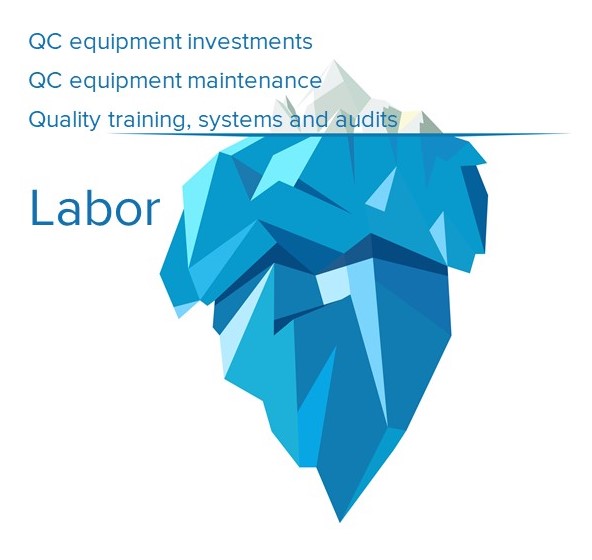Although we carefully monitor costs in manufacturing, many costs are not top of mind because they’re out of sight. Like an iceberg, most of the cost mass remains hidden underwater.
For small-component part manufacturers, quality is critical and requires a budget. In fact, quality is often considered to be such a key part of a small-component part manufacturing operation that quality costs are a significant percentage of revenue. Depending on the operation, the part quality cost or value could be as much as 10% of the value of the component.
Minimizing the risks
The most important goal of quality for a manufacturer is usually minimizing the risk of shipping bad or poor products to customers. In our just-in-time manufacturing environments, inferior or sub-standard components can shut down a line and prevent the customer from making what they need to manufacture for that shift, for that day or for the week. Your customer may never trust you again, and it may take a long time to rebuild that relationship.
Supplying inferior parts can be extremely expensive with massive penalties and even termination of contracts. The best-case scenario for you as the supplier would be that you have to investigate, measure, and replace bad parts with good parts. Even if you didn’t incur monetary penalties, your reputation and brand would suffer, compromising future revenue.
What are traditional above-the-water manufacturing quality costs?
Investing in Quality Control Equipment
Manufacturers need a lot of equipment for quality control, ranging from hand tools to software to high-end metrology vision devices. Pin gauges, go and no-go gauges, Vernier calipers, gauge blocks, coordinate measuring machines, software, and other types of equipment are easy to recognize and inventory. This type of equipment represents the hard costs of maintaining quality protocols.
Maintaining Quality Control Equipment
Once you bring in precision measuring equipment, whether it’s mechanical or electronic, you need to maintain it. Cleaning, calibration, and repair add cost to the ownership of quality control equipment.
Quality Training, Systems, and Audits
Being part of the manufacturing industry usually means participating in quality systems such as ISO 9000. Saying what you do and doing what you say is your commitment to your customers. Proving that you adhere to these systems includes recording quality measurements and keeping an audit trail, which can be labor-intensive and prone to human error when done manually.
To ensure that any quality issues are identified as early as possible, people need to be trained in best practices and how to use equipment. Training must be kept up to date, requiring workers to spend time away from production.
Systems and best practices need to be enforced, which requires supervision. Training your staff, documenting processes, and maintaining auditable records are part of the cost of doing business.
What are the hidden below-the-water manufacturing quality costs?
Supplying Necessary Labor to Maintain Quality in Manufacturing
Labor is one of the most significant costs in manufacturing and in maintaining quality standards. Manufacturers are aware that labor is required for quality and will include labor as an overhead cost. A production manager will say, “If we make a million more widgets, we’ll need to increase our quality control capacity, so we’ll need another person.”
The hidden cost is finding enough workers to fill labor requirements. This is where you hit the massive, unavoidable, underwater part of the iceberg.
One of the biggest challenges today for all manufacturers is attracting and retaining skilled talent; they are just not there. New generations entering the work force are not interested in manufacturing jobs like their parents and grandparents were. We’re facing the greatest challenge to manufacturing in decades: low unemployment rates and a looming skills gap.
Even if you manage to navigate around the above-the-water quality costs of manufacturing, the lack of skilled labor can sink your metaphorical ship.
What’s a reasonable solution to the quality control skills gap in manufacturing?
Automation and robotics
Automation significantly reduces labor requirements for certain quality control tasks. In fact, robots can often perform tedious quality inspections with higher repeatability and precision than humans can. By automating quality control, you can devote your limited supply of skilled labor to the jobs people are really good at: thinking and problem solving.
Quality control solutions for small-part manufacturers
At New Scale Robotics we recognize the importance of creating innovative tools to tackle challenges for small-part manufacturers. Our Q-Span™ Workstation is an innovative approach to automating small-part measurement for high-mix small-batch manufacturing. The simple value proposition of Q-Span Workstations is to automate manual part measurements that today use digital calipers, and do it with a return on investment in less than 10 months.
Q-Span Systems target the massive below-the-water cost of quality. They help you improve gauge R&R, multiply productivity, elevate your employees’ skill levels,reduce errors, minimize injuries, and increase employee engagement.
To find out if your components are a good fit for Q-Span, contact our customer service and applications engineering at +1 (585) 924-4450 or via email at NSRsales@newscalerobotics.com.

